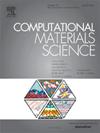Numerical micromechanics-based evaluation of mechanical and thermal properties of polypropylene/MMT clay nanocomposites
IF 3.3
3区 材料科学
Q2 MATERIALS SCIENCE, MULTIDISCIPLINARY
引用次数: 0
Abstract
This study numerically investigates mechanical and thermal properties of polypropylene/montmorillonite (MMT) clay nanocomposites, focusing on Young's modulus, thermal expansion coefficient (TEC), and thermal conductivity. A three-phase representative volume element (RVE) with periodic boundary conditions (PBCs), incorporating polypropylene matrix, MMT clay nanoplatelets and an interphase, is employed to conduct micromechanics-based finite element simulations. The interphase, modeled with variable characteristics, represents the interaction zone between the matrix and nanofillers. The MMT clay nanoplatelets are dispersed randomly, aligned and agglomerated within the polypropylene matrix, with their aspect ratio and volume fraction systematically changed to investigate the microstructural influences on the nanocomposite's properties. Uniform dispersing MMT clay nanoplatelets into the polypropylene matrix is found to improve the elastic modulus, TEC and thermal conductivity of resulting nanocomposites. However, the nanofiller agglomeration leads to localized stress concentrations, potentially reducing mechanical properties, and introduces thermal barriers that can lower overall thermal conductivities. Results show that alignment of MMT clay nanoplatelets within the polypropylene matrix can be useful from the structural point of view because the nanocomposite gives higher material performances in the longitudinal direction as compared to other states. Higher aspect ratios, where nanoplatelets are aligned, lead to more improvements in the nanocomposite longitudinal properties. Comparisons reveal a good agreement between present numerical results and existing data in the literature.

基于数值细观力学的聚丙烯/MMT粘土纳米复合材料力学和热性能评价
本研究对聚丙烯/蒙脱土(MMT)纳米复合材料的力学和热性能进行了数值研究,重点研究了杨氏模量、热膨胀系数(TEC)和导热系数。采用具有周期边界条件(pbc)的三相代表性体积单元(RVE),结合聚丙烯基体、MMT粘土纳米薄片和间相,进行了基于细观力学的有限元模拟。界面具有可变特征,表示基质与纳米填料之间的相互作用区域。在聚丙烯基体中随机分散、排列和团聚,系统地改变其长径比和体积分数,研究微观结构对纳米复合材料性能的影响。在聚丙烯基体中均匀分散的MMT粘土纳米片提高了复合材料的弹性模量、TEC和导热系数。然而,纳米填料的团聚会导致局部应力集中,潜在地降低机械性能,并引入热障,从而降低整体导热系数。结果表明,从结构的角度来看,MMT粘土纳米片在聚丙烯基体中的排列是有用的,因为与其他状态相比,纳米复合材料在纵向上具有更高的材料性能。更高的纵横比,纳米片排列,导致更多的改善纳米复合材料的纵向性能。比较表明,目前的数值结果和文献中的现有数据之间有很好的一致性。
本文章由计算机程序翻译,如有差异,请以英文原文为准。
求助全文
约1分钟内获得全文
求助全文
来源期刊

Computational Materials Science
工程技术-材料科学:综合
CiteScore
6.50
自引率
6.10%
发文量
665
审稿时长
26 days
期刊介绍:
The goal of Computational Materials Science is to report on results that provide new or unique insights into, or significantly expand our understanding of, the properties of materials or phenomena associated with their design, synthesis, processing, characterization, and utilization. To be relevant to the journal, the results should be applied or applicable to specific material systems that are discussed within the submission.
 求助内容:
求助内容: 应助结果提醒方式:
应助结果提醒方式:


